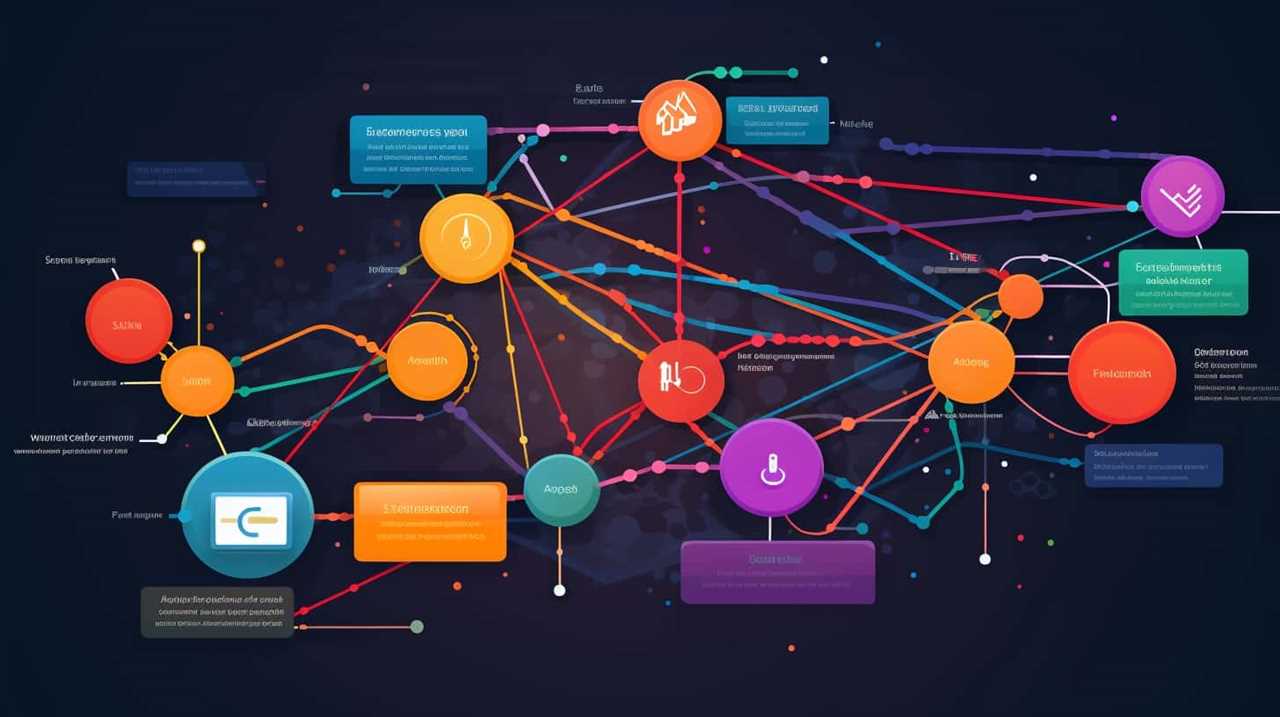Ah, the thrill of triumph in the digital realm! We, the specialists in Google Ads, have discovered the key to achieving success in the toy store industry.
With our strategic targeting, engaging ad copy, and clever use of ad extensions, we’ll have those sales soaring.
But that’s not all – we’ll maximize your ad budget efficiency, leverage the power of the Google Display Network, and even incorporate local targeting.
So buckle up, fellow marketers, as we guide you through the realm of Google Ads for toy stores.

Let’s play and win together!
Key Takeaways
- Targeting the right audience and creating engaging ad copy is crucial for success in Google Ads for toy stores.
- Utilizing ad extensions can increase visibility and attract more clicks from potential customers.
- Implementing conversion tracking is essential for running successful campaigns and optimizing ad performance.
- Maximizing ad budget efficiency and testing ad performance are important strategies for achieving digital success in Google Ads for toy stores.
- Local targeting and remarketing strategies can help maximize advertising budget, increase conversions, and enhance the customer’s shopping experience.
Targeting the Right Audience
Targeting the right audience involves identifying potential customers who are interested in purchasing toys and engaging them through effective advertising strategies. In order to maximize the success of a toy store, it’s crucial to identify niche markets within the broader target audience. By doing so, we can tailor our advertising efforts to reach those specific groups who are most likely to be interested in our products.
One way to identify niche markets is by utilizing demographic targeting. This involves analyzing data on age, gender, location, and other relevant factors to determine the characteristics of our ideal customers. For example, if our research shows that young parents with preschool-aged children are a key demographic, we can create ads specifically designed to appeal to them.
Additionally, demographic targeting allows us to understand the unique needs and preferences of different customer segments. By tailoring our advertising messages to these specific groups, we can increase the likelihood of capturing their attention and driving them to make a purchase.

Creating Engaging Ad Copy
To create engaging ad copy, we focus on capturing the attention of our potential customers with compelling and persuasive language. Our goal is to improve ad relevance and optimize ad placements to ensure that our ads are seen by the right audience at the right time.
Here are five strategies we employ to create engaging ad copy:
- Tailoring the message: We craft ad copy that speaks directly to the needs and desires of our target audience. By understanding their pain points and aspirations, we can create copy that resonates with them on a personal level.
- Using strong headlines: We know that the headline is the first thing people see, so we make sure it grabs their attention and entices them to click. We use powerful, concise language that sparks curiosity and compels them to learn more.
- Highlighting benefits: Instead of focusing solely on product features, we emphasize the benefits our toys provide. Whether it’s fostering creativity, promoting learning, or sparking imagination, we show customers how our toys can enhance their lives.
- Incorporating social proof: We include testimonials, reviews, and ratings in our ad copy to build trust and credibility. By showcasing positive experiences from satisfied customers, we demonstrate the value and quality of our toys.
- Creating a sense of urgency: We use time-limited offers, limited stock notifications, and countdowns to create a sense of urgency and encourage immediate action.
By implementing these strategies, we create ad copy that engages our audience and drives conversions.
Now, let’s explore how we can further enhance our ads by utilizing ad extensions.

Utilizing Ad Extensions
When it comes to maximizing the effectiveness of Google Ads, utilizing ad extensions is key. Ad extensions not only boost click-through rates, but also increase ad visibility, allowing your toy store to stand out from the competition.
Boosting Click-Through Rates
As digital marketers, we continuously explore ways to enhance click-through rates by leveraging ad extensions. Ad extensions are powerful tools that allow us to provide additional information and enhance the visibility of our ads.
Here are five strategies we can use to boost click-through rates:
- Utilize Sitelink Extensions: By adding sitelinks to our ads, we can direct users to specific pages on our website, increasing the chances of them clicking through.
- Include Callout Extensions: These highlight key features or offers, making our ads more compelling and enticing users to click.
- Use Structured Snippet Extensions: By showcasing specific categories or product lines, we can give users a taste of what we offer, enticing them to click for more.
- Implement Location Extensions: For local toy stores, displaying store locations and contact information can drive more foot traffic and clicks.
- Take Advantage of Call Extensions: By including a phone number in our ads, we make it easy for users to contact us directly, increasing the likelihood of a click.
Increasing Ad Visibility
How can we maximize ad visibility for toy stores using ad extensions? One effective strategy is to utilize various ad extensions to provide additional information and increase the chances of attracting clicks. Ad extensions allow us to expand our ads with more relevant details, making them more prominent and appealing to potential customers. By improving ad targeting and optimizing bidding strategies, we can further enhance the visibility of our ads and increase their effectiveness.

To illustrate this concept, let’s consider a table showcasing different ad extensions and their benefits:
| Ad Extension | Benefits |
|---|---|
| Sitelink | Direct users to specific pages on our website |
| Callout | Highlight key features or unique selling points |
| Structured Snippet | Display additional information in a structured format |
Implementing Conversion Tracking
When it comes to running successful Google Ads campaigns for toy stores, implementing conversion tracking is essential.
By tracking ad performance, we can gather valuable data on which ads are driving the most conversions. This allows us to optimize our campaigns and focus on the strategies that yield the highest conversion rates.
Additionally, accurate ROI measurement becomes possible, enabling us to allocate our budget more effectively and maximize our return on investment.

Tracking Ad Performance
We implemented conversion tracking to accurately measure the performance of our Google Ads for toy stores. By tracking ad performance, we were able to gain valuable insights and make data-driven decisions to optimize our ad campaigns.
Here are some key benefits of implementing conversion tracking:
- Improved ad targeting: Conversion tracking allowed us to understand which keywords and targeting options were driving the most conversions. This information helped us refine our targeting strategies and focus our advertising efforts on the most effective audience segments.
- Optimized ad placement: By tracking conversions, we could identify which ad placements were generating the highest conversion rates. This knowledge allowed us to prioritize those placements and allocate our budget more effectively.
- Enhanced campaign optimization: Conversion tracking provided us with real-time data on the performance of our ads. With this information, we could quickly identify underperforming ads and make necessary adjustments to improve their effectiveness.
- Increased ROI: By leveraging conversion tracking, we were able to optimize our ad campaigns to generate more conversions while minimizing wasted ad spend. This resulted in a higher return on investment (ROI) for our toy store.
- Data-driven decision making: Conversion tracking provided us with actionable data that guided our decision-making process. We could analyze the performance of different ad elements, such as headlines, images, and calls to action, and make informed changes to maximize conversions.
With conversion tracking in place, we were able to gain a deeper understanding of our ad performance and make strategic decisions to improve our campaigns.
Now, let’s dive into the next step of our journey: optimizing conversion rates.

Optimizing Conversion Rates
To further improve our Google Ads campaigns for toy stores, we implemented conversion tracking, allowing us to optimize conversion rates and drive digital success.
Conversion tracking is a powerful tool that enables us to track and analyze the actions taken by users on our website after clicking on our ads. By understanding which keywords, ads, and campaigns are driving the most conversions, we can make data-driven decisions to enhance our advertising strategy.
Additionally, conversion tracking helps us identify areas for improvement in our website navigation and landing page design. By analyzing user behavior, we can identify any potential barriers that may hinder conversions and take steps to optimize the user experience.
By implementing conversion tracking and making adjustments based on the insights gained, we can maximize our conversion rates and achieve more meaningful results.

In the next section, we’ll discuss the importance of measuring ROI accurately.
Measuring ROI Accurately
By implementing conversion tracking, we can accurately measure the return on investment (ROI) for our Google Ads campaigns for toy stores. This allows us to understand the effectiveness of our campaigns and make data-driven decisions to optimize our advertising strategies.
To measure campaign effectiveness and track ad spend, we can utilize the following methods:
- Set up conversion tracking: By placing a tracking code on our website, we can track specific actions such as purchases or sign-ups that result from our Google Ads campaigns.
- Analyze conversion data: With conversion tracking in place, we can analyze data such as conversion rate, cost per conversion, and overall ROI to gauge the success of our campaigns.
- Adjust campaign settings: By monitoring conversion data, we can make informed decisions about budget allocation, keyword targeting, and ad copy optimization to improve campaign performance.
- A/B testing: Conversion tracking allows us to test different ad variations and landing pages to identify what drives the highest conversion rates.
- Optimize ad spend: By tracking ad spend alongside conversion data, we can determine the cost-effectiveness of our campaigns and allocate our budget more efficiently.
With these conversion tracking techniques, we can accurately measure campaign effectiveness and make data-driven decisions to maximize our ROI and drive success for toy stores.

Maximizing Ad Budget Efficiency
As marketers, our goal is to optimize ad budget efficiency when using Google Ads for toy stores. By improving ad targeting and optimizing ad spend, we can ensure that our campaigns are reaching the right audience while making the most of our budget. One effective way to achieve this is by utilizing the various targeting options available on the Google Ads platform.
To give you a better understanding of how to maximize ad budget efficiency, let’s take a look at the following table:
| Targeting Option | Description |
|---|---|
| Location | Target specific geographic areas where your toy store operates or has the potential for customers. |
| Demographics | Tailor your ads based on factors such as age, gender, and household income to reach your ideal customers. |
| Interests | Target individuals who have shown an interest in toys, children’s entertainment, or related topics. |
| Keywords | Select relevant keywords that align with your toy store’s offerings to display your ads to users searching for those terms. |
By utilizing these targeting options strategically, we can ensure that our ads are shown to the right people at the right time, maximizing the efficiency of our ad budget. Additionally, regularly monitoring and analyzing campaign performance will allow us to make data-driven adjustments, further optimizing our ad spend.
Testing and Optimizing Ad Performance
We can further enhance the success of our Google Ads campaigns for toy stores by continuously testing and optimizing ad performance. By employing A/B testing strategies and conducting thorough ad performance analysis, we can ensure that our ads are delivering the best possible results.

Here are five key steps to help us achieve this:
- Conduct A/B tests: Run multiple versions of our ads simultaneously to determine which variations perform better in terms of click-through rates, conversions, and other key metrics.
- Analyze ad performance: Regularly review and analyze the performance of our ads to identify trends, patterns, and areas for improvement.
- Optimize ad copy: Continuously refine our ad copy to make it more compelling, engaging, and relevant to our target audience.
- Test different ad formats: Experiment with various ad formats, such as text ads, image ads, and video ads, to see which ones resonate best with our audience.
- Refine targeting options: Adjust our targeting options, including demographics, locations, and interests, to ensure that our ads are reaching the right people at the right time.
Leveraging Google Display Network
When it comes to leveraging the Google Display Network for toy stores, there are three key points to consider.
First, targeting toy enthusiasts is crucial for maximizing ad reach and connecting with the right audience.
Second, by utilizing the display network, toy stores can showcase their products and promotions on relevant websites and apps, increasing visibility.

Lastly, tracking campaign effectiveness is essential to measure the impact of the ads and make necessary adjustments for optimal results.
Targeting Toy Enthusiasts
To effectively reach toy enthusiasts, toy stores can utilize the Google Display Network to target their ideal audience. This powerful advertising platform allows toy stores to showcase their products and promotions to individuals who’ve shown an interest in toy trends and online toy shopping. By leveraging the Google Display Network, toy stores can strategically position their ads on websites and apps that are frequented by toy enthusiasts, maximizing visibility and engagement.
Here are some key benefits of targeting toy enthusiasts through the Google Display Network:
- Precise audience targeting based on demographics, interests, and online behavior.
- Expanded reach and visibility among potential customers.
- Increased brand awareness and recognition.
- Opportunity to showcase new products and trends.
- Cost-effective advertising with measurable results.
Maximizing Ad Reach
By leveraging the Google Display Network, toy stores can maximize their ad reach and effectively target their ideal audience of toy enthusiasts. The Google Display Network is a powerful tool that allows advertisers to showcase their ads across a wide range of websites, reaching millions of potential customers. This network consists of websites, mobile apps, and video platforms that partner with Google to display ads. By utilizing this network, toy stores can improve their ad targeting and increase their ad impressions, ultimately driving more traffic to their online and physical stores.

To illustrate the potential of the Google Display Network, consider the following table:
| Pros of Leveraging Google Display Network | Cons of Leveraging Google Display Network | Strategies for Maximizing Ad Reach |
|---|---|---|
| Wide reach across various websites | Potential for ad fatigue | Utilize demographic targeting |
| Targeting options for specific audiences | Ad placement may not always be relevant | Optimize ad design and copy |
| Ability to track and measure ad performance | Ad blockers may impact impressions | Use remarketing to reach past visitors |
Tracking Campaign Effectiveness
We can track the effectiveness of our campaigns on the Google Display Network by utilizing various metrics and tools provided by Google. Here are some ways we can track and analyze the success of our campaigns:
- Cost per click (CPC): This metric allows us to see how much we’re spending on each click and helps us evaluate the efficiency of our campaign budget.
- Click-through rate (CTR): By analyzing the CTR, we can measure the percentage of users who clicked on our ads compared to the number of impressions, giving us insights into the relevancy and performance of our ads.
- Conversion tracking: This tool enables us to track the actions taken by users after clicking on our ads, such as purchases or form submissions, helping us gauge the effectiveness of our campaigns in driving conversions.
- Audience insights: Google provides valuable demographic and interest data about the users who interact with our ads, allowing us to tailor future campaigns to better target our desired audience.
- A/B testing: By running multiple versions of our ads and comparing their performance, we can identify the most effective ad variations and optimize our campaign strategy.
By tracking campaign costs and analyzing conversion data, we can make data-driven decisions to improve the effectiveness of our advertising efforts.
Now, let’s explore how we can further enhance our campaigns by utilizing remarketing strategies.

Utilizing Remarketing Strategies
Let’s explore how we can make the most of remarketing strategies in our Google Ads campaign for toy stores. Remarketing is a powerful tool that allows us to reach out to potential customers who’ve already shown interest in our products.
By utilizing dynamic ads, we can create personalized advertisements that showcase the toys that these customers have previously viewed or added to their shopping carts. This not only reminds them of the products they were interested in but also creates a sense of familiarity and increases the likelihood of conversion.
In addition to utilizing dynamic ads, we can also implement cross-selling strategies to maximize the effectiveness of our remarketing efforts. By analyzing the purchasing behavior of our customers, we can identify related products that are often bought together and create targeted ads promoting these combinations.
For example, if a customer has purchased a LEGO set, we can show them ads for compatible add-ons or other LEGO sets that complement their purchase. This not only increases the average order value but also enhances the customer’s overall shopping experience.

By incorporating these remarketing strategies, we can effectively engage with our potential customers and increase the chances of conversion. However, remarketing alone isn’t enough.
In the next section, we’ll explore the importance of incorporating local targeting into our Google Ads campaign to further optimize our results.
Incorporating Local Targeting
To enhance the effectiveness of our Google Ads campaign for toy stores, we can incorporate local targeting to reach a specific audience within a designated geographical area. Local advertising allows us to connect with potential customers who are physically close to our toy stores, increasing the likelihood of conversions and foot traffic. By implementing geo targeting strategies, we can tailor our ads to specific locations, ensuring that our message reaches the right people at the right time.
Here are five key ways we can incorporate local targeting into our Google Ads campaign:

- Utilize location extensions: Adding location extensions to our ads allows us to display our store address, phone number, and a map marker, making it easier for potential customers to find us.
- Target specific areas: By selecting specific cities, regions, or even postal codes, we can ensure that our ads are only shown to people within the targeted area, maximizing our advertising budget.
- Use location-based keywords: Including location-specific keywords in our ad copy can help us attract customers who are actively looking for toy stores in their area.
- Implement local ad scheduling: By scheduling our ads to run during specific times of the day or week, we can optimize our campaign to reach potential customers when they’re most likely to be searching for toys.
- Monitor and analyze local ad performance: Regularly reviewing and analyzing the performance of our local ads can provide valuable insights into which areas are generating the most engagement and conversions, allowing us to make data-driven decisions to further optimize our campaign.
Incorporating local targeting into our Google Ads campaign for toy stores is a strategic approach that can significantly increase our visibility and drive more foot traffic to our stores. By leveraging the power of location-based advertising, we can connect with our target audience on a hyper-local level, maximizing the return on our advertising investment.
Tracking and Analyzing Campaign Results
To track and analyze the results of our local targeting efforts in our Google Ads campaign for toy stores, we can utilize various metrics and tools to gain valuable insights into the effectiveness of our advertising strategy.
Tracking campaign success is crucial in order to understand how our ads are performing and to make informed decisions on how to optimize our campaigns.
One important metric we can use is the click-through rate (CTR), which measures the percentage of people who click on our ads after seeing them. A high CTR indicates that our ads are resonating with our target audience and driving traffic to our website.

Another metric we can analyze is the conversion rate, which measures the percentage of people who take a desired action, such as making a purchase, after clicking on our ads. By tracking the conversion rate, we can determine the effectiveness of our ads in generating sales and revenue.
In addition to these metrics, we can also analyze customer behavior by using tools like Google Analytics. This allows us to track user engagement on our website, such as the number of page views, time spent on site, and bounce rate. By understanding how customers are interacting with our website, we can make data-driven decisions to improve user experience and increase conversions.
Frequently Asked Questions
How Can Toy Stores Effectively Target a Specific Audience Using Google Ads?
To effectively target a specific audience using Google Ads, toy stores can employ various targeting strategies and ad targeting techniques. By identifying the interests, demographics, and online behaviors of their target customers, toy stores can tailor their ads for maximum impact and success.
What Are Some Techniques for Creating Captivating Ad Copy That Grabs the Attention of Potential Customers?
Creating persuasive ad copy is an art. By employing strategic techniques, we can increase click-through rates and grab the attention of potential customers. It’s all about captivating their imagination and sparking their curiosity.

What Are the Benefits of Utilizing Ad Extensions in Google Ads Campaigns for Toy Stores?
Using ad extensions in Google Ads campaigns for toy stores has numerous benefits. They increase our ad visibility, allowing us to showcase more information and stand out from competitors. This strategic tactic helps us capture the attention of potential customers and drive higher conversion rates.
How Can Toy Stores Implement Conversion Tracking to Measure the Success of Their Google Ads Campaigns?
To implement conversion tracking and measure campaign success, we need to set up tracking codes on our website, define conversion goals, and link them to our Google Ads account. This allows us to analyze performance and optimize our advertising strategies.
What Strategies Can Toy Stores Employ to Maximize the Efficiency of Their Ad Budget?
To maximize our ad budget and optimize keywords, we develop a strategic approach. By continuously analyzing data and staying ahead of trends, we ensure our campaigns are efficient and effective, delivering exceptional results.
Conclusion
In the world of toy stores, Google Ads is the key to unlocking digital success. By targeting the right audience, creating engaging ad copy, and utilizing ad extensions, toy stores can maximize their ad budget efficiency and reach new heights.

With the power of the Google Display Network and remarketing strategies, they can captivate potential customers and bring them back for more.
By incorporating local targeting and tracking campaign results, toy stores can stay ahead of the game and drive their success to new levels of playfulness.










